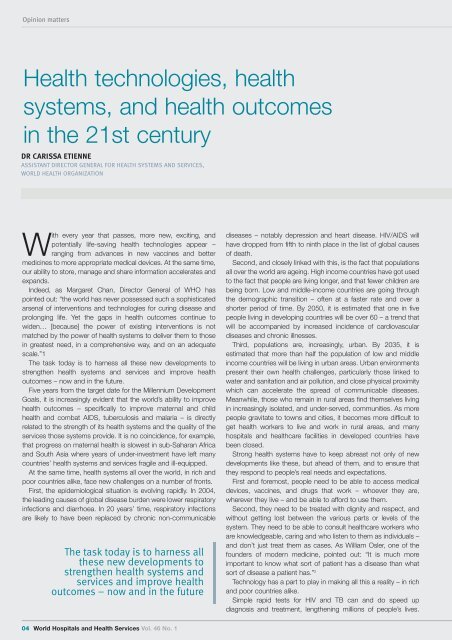vol46.1 LR.pdf - International Hospital Federation
vol46.1 LR.pdf - International Hospital Federation
vol46.1 LR.pdf - International Hospital Federation
You also want an ePaper? Increase the reach of your titles
YUMPU automatically turns print PDFs into web optimized ePapers that Google loves.
Opinion matters<br />
Health technologies, health<br />
systems, and health outcomes<br />
in the 21st century<br />
DR CARISSA ETIENNE<br />
ASSISTANT DIRECTOR GENERAL FOR HEALTH SYSTEMS AND SERVICES,<br />
WORLD HEALTH ORGANIZATION<br />
With every year that passes, more new, exciting, and<br />
potentially life-saving health technologies appear –<br />
ranging from advances in new vaccines and better<br />
medicines to more appropriate medical devices. At the same time,<br />
our ability to store, manage and share information accelerates and<br />
expands.<br />
Indeed, as Margaret Chan, Director General of WHO has<br />
pointed out: “the world has never possessed such a sophisticated<br />
arsenal of interventions and technologies for curing disease and<br />
prolonging life. Yet the gaps in health outcomes continue to<br />
widen… [because] the power of existing interventions is not<br />
matched by the power of health systems to deliver them to those<br />
in greatest need, in a comprehensive way, and on an adequate<br />
scale.”1<br />
The task today is to harness all these new developments to<br />
strengthen health systems and services and improve health<br />
outcomes – now and in the future.<br />
Five years from the target date for the Millennium Development<br />
Goals, it is increasingly evident that the world’s ability to improve<br />
health outcomes – specifically to improve maternal and child<br />
health and combat AIDS, tuberculosis and malaria – is directly<br />
related to the strength of its health systems and the quality of the<br />
services those systems provide. It is no coincidence, for example,<br />
that progress on maternal health is slowest in sub-Saharan Africa<br />
and South Asia where years of under-investment have left many<br />
countries’ health systems and services fragile and ill-equipped.<br />
At the same time, health systems all over the world, in rich and<br />
poor countries alike, face new challenges on a number of fronts.<br />
First, the epidemiological situation is evolving rapidly. In 2004,<br />
the leading causes of global disease burden were lower respiratory<br />
infections and diarrhoea. In 20 years’ time, respiratory infections<br />
are likely to have been replaced by chronic non-communicable<br />
The task today is to harness all<br />
these new developments to<br />
strengthen health systems and<br />
services and improve health<br />
outcomes – now and in the future<br />
diseases – notably depression and heart disease. HIV/AIDS will<br />
have dropped from fifth to ninth place in the list of global causes<br />
of death.<br />
Second, and closely linked with this, is the fact that populations<br />
all over the world are ageing. High income countries have got used<br />
to the fact that people are living longer, and that fewer children are<br />
being born. Low and middle-income countries are going through<br />
the demographic transition – often at a faster rate and over a<br />
shorter period of time. By 2050, it is estimated that one in five<br />
people living in developing countries will be over 60 – a trend that<br />
will be accompanied by increased incidence of cardiovascular<br />
diseases and chronic illnesses.<br />
Third, populations are, increasingly, urban. By 2035, it is<br />
estimated that more than half the population of low and middle<br />
income countries will be living in urban areas. Urban environments<br />
present their own health challenges, particularly those linked to<br />
water and sanitation and air pollution, and close physical proximity<br />
which can accelerate the spread of communicable diseases.<br />
Meanwhile, those who remain in rural areas find themselves living<br />
in increasingly isolated, and under-served, communities. As more<br />
people gravitate to towns and cities, it becomes more difficult to<br />
get health workers to live and work in rural areas, and many<br />
hospitals and healthcare facilities in developed countries have<br />
been closed.<br />
Strong health systems have to keep abreast not only of new<br />
developments like these, but ahead of them, and to ensure that<br />
they respond to people’s real needs and expectations.<br />
First and foremost, people need to be able to access medical<br />
devices, vaccines, and drugs that work – whoever they are,<br />
wherever they live – and be able to afford to use them.<br />
Second, they need to be treated with dignity and respect, and<br />
without getting lost between the various parts or levels of the<br />
system. They need to be able to consult healthcare workers who<br />
are knowledgeable, caring and who listen to them as individuals –<br />
and don’t just treat them as cases. As William Osler, one of the<br />
founders of modern medicine, pointed out: “It is much more<br />
important to know what sort of patient has a disease than what<br />
sort of disease a patient has.” 2<br />
Technology has a part to play in making all this a reality – in rich<br />
and poor countries alike.<br />
Simple rapid tests for HIV and TB can and do speed up<br />
diagnosis and treatment, lengthening millions of people’s lives.<br />
04 World <strong>Hospital</strong>s and Health Services Vol. 46 No. 1

















